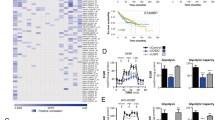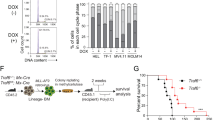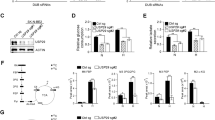Abstract
Myeloproliferative neoplasms are characterized by overproduction of myeloid lineage cells with frequent acquisition of oncogenic JAK2V617F kinase mutations. The molecular mechanisms that regulate energy requirements in these diseases are poorly understood. Transformed cells tend to rely on fermentation instead of more efficient oxidative phosphorylation for energy production. Our data in JAK2V617F-transformed cells show that growth and metabolic activity were strictly dependent on the presence of glucose. Uptake of glucose and cell surface expression of the glucose transporter Glut1 required the oncogenic tyrosine kinase. Importantly, JAK2V617F as well as active STAT5 increased the expression of the inducible rate-limiting enzyme 6-phosphofructo-2-kinase/fructose-2,6-bisphosphatase 3 (PFKFB3), which controls glycolytic flux through 6-phosphofructo-1-kinase. PFKFB3 was required for JAK2V617F-dependent lactate production, oxidative metabolic activity and glucose uptake. Targeted knockdown of PFKFB3 also limited cell growth under normoxic and hypoxic conditions and blocked in vivo tumor formation in mice. Overall, these data suggest that inducible PFKFB3 is required for increased growth, metabolic activity and is regulated through active JAK2 and STAT5. Novel therapies that specifically block PFKFB3 activity or expression would, therefore, be expected to inhibit JAK2/STAT5-dependent malignancies and related cancers.
This is a preview of subscription content, access via your institution
Access options
Subscribe to this journal
Receive 12 print issues and online access
$259.00 per year
only $21.58 per issue
Buy this article
- Purchase on Springer Link
- Instant access to full article PDF
Prices may be subject to local taxes which are calculated during checkout





Similar content being viewed by others
References
Levine RL, Gilliland DG . Myeloproliferative disorders. Blood 2008; 112: 2190–2198.
Bercovich D, Ganmore I, Scott LM, Wainreb G, Birger Y, Elimelech A et al. Mutations of JAK2 in acute lymphoblastic leukaemias associated with Down's syndrome. Lancet 2008; 372: 1484–1492.
Reiter A, Walz C, Watmore A, Schoch C, Blau I, Schlegelberger B et al. The t(8;9)(p22;p24) is a recurrent abnormality in chronic and acute leukemia that fuses PCM1 to JAK2. Cancer Res 2005; 65: 2662–2667.
Teglund S, McKay C, Schuetz E, van Deursen JM, Stravopodis D, Wang D et al. Stat5a and Stat5b proteins have essential and nonessential, or redundant, roles in cytokine responses. Cell 1998; 93: 841–850.
Hennighausen L, Robinson GW . Interpretation of cytokine signaling through the transcription factors STAT5A and STAT5B. Genes Dev 2008; 22: 711–721.
Warburg O . On respiratory impairment in cancer cells. Science 1956; 124: 269–270.
Pedersen PL . Tumor mitochondria and the bioenergetics of cancer cells. Prog Exp Tumor Res 1978; 22: 190–274.
Yalcin A, Telang S, Clem B, Chesney J . Regulation of glucose metabolism by 6-phosphofructo-2-kinase/fructose-2,6-bisphosphatases in cancer. Exp Mol Pathol 2009; 86: 174–179.
Van Schaftingen E, Hue L, Hers HG . Fructose 2,6-bisphosphate, the probably structure of the glucose- and glucagon-sensitive stimulator of phosphofructokinase. Biochem J 1980; 192: 897–901.
Uyeda K, Furuya E, Luby LJ . The effect of natural and synthetic D-fructose 2,6-bisphosphate on the regulatory kinetic properties of liver and muscle phosphofructokinases. J Biol Chem 1981; 256: 8394–8399.
Van Schaftingen E, Hers HG . Inhibition of fructose-1,6-bisphosphatase by fructose 2,6-biphosphate. Proc Natl Acad Sci USA 1981; 78: 2861–2863.
Wernig G, Gonneville JR, Crowley BJ, Rodrigues MS, Reddy MM, Hudon HE et al. The Jak2V617F oncogene associated with myeloproliferative diseases requires a functional FERM domain for transformation and for expression of the Myc and Pim proto-oncogenes. Blood 2008; 111: 3751–3759.
Reddy MM, Fernandes MS, Salgia R, Levine RL, Griffin JD, Sattler M . NADPH oxidases regulate cell growth and migration in myeloid cells transformed by oncogenic tyrosine kinases. Leukemia 2011; 25: 281–289.
Fernandes MS, Reddy MM, Gonneville JR, DeRoo SC, Podar K, Griffin JD et al. BCR-ABL promotes the frequency of mutagenic single-strand annealing DNA repair. Blood 2009; 114: 1813–1819.
Van Schaftingen E, Lederer B, Bartrons R, Hers HG . A kinetic study of pyrophosphate: fructose-6-phosphate phosphotransferase from potato tubers. Application to a microassay of fructose 2,6-bisphosphate. Eur J Biochem 1982; 129: 191–195.
Gordan JD, Thompson CB, Simon MC . HIF and c-Myc: sibling rivals for control of cancer cell metabolism and proliferation. Cancer Cell 2007; 12: 108–113.
Dang CV, Kim JW, Gao P, Yustein J . The interplay between MYC and HIF in cancer. Nat Rev Cancer 2008; 8: 51–56.
Clem B, Telang S, Clem A, Yalcin A, Meier J, Simmons A et al. Small-molecule inhibition of 6-phosphofructo-2-kinase activity suppresses glycolytic flux and tumor growth. Mol Cancer Ther 2008; 7: 110–120.
Fatrai S, Wierenga AT, Daenen SM, Vellenga E, Schuringa JJ . Identification of HIF2alpha as an important STAT5 target gene in human hematopoietic stem cells. Blood 2011; 117: 3320–3330.
Herrero-Mendez A, Almeida A, Fernandez E, Maestre C, Moncada S, Bolanos JP . The bioenergetic and antioxidant status of neurons is controlled by continuous degradation of a key glycolytic enzyme by APC/C-Cdh1. Nat Cell Biol 2009; 11: 747–752.
Bando H, Atsumi T, Nishio T, Niwa H, Mishima S, Shimizu C et al. Phosphorylation of the 6-phosphofructo-2-kinase/fructose 2,6-bisphosphatase/PFKFB3 family of glycolytic regulators in human cancer. Clin Cancer Res 2005; 11: 5784–5792.
Kessler R, Eschrich K . Splice isoforms of ubiquitous 6-phosphofructo-2-kinase/fructose-2,6-bisphosphatase in human brain. Brain Res Mol Brain Res 2001; 87: 190–195.
Ahonen TJ, Xie J, LeBaron MJ, Zhu J, Nurmi M, Alanen K et al. Inhibition of transcription factor Stat5 induces cell death of human prostate cancer cells. J Biol Chem 2003; 278: 27287–27292.
Lai SY, Johnson FM . Defining the role of the JAK-STAT pathway in head and neck and thoracic malignancies: implications for future therapeutic approaches. Drug Resist Updat 2010; 13: 67–78.
Clevenger CV . Roles and regulation of stat family transcription factors in human breast cancer. Am J Pathol 2004; 165: 1449–1460.
Atsumi T, Chesney J, Metz C, Leng L, Donnelly S, Makita Z et al. High expression of inducible 6-phosphofructo-2-kinase/fructose-2,6-bisphosphatase (iPFK-2; PFKFB3) in human cancers. Cancer Res 2002; 62: 5881–5887.
Kessler R, Bleichert F, Warnke JP, Eschrich K . 6-Phosphofructo-2-kinase/fructose-2,6-bisphosphatase (PFKFB3) is up-regulated in high-grade astrocytomas. J Neurooncol 2008; 86: 257–264.
Fang M, Shen Z, Huang S, Zhao L, Chen S, Mak TW et al. The ER UDPase ENTPD5 promotes protein N-glycosylation, the Warburg effect, and proliferation in the PTEN pathway. Cell 2010; 143: 711–724.
Kim JH, Chu SC, Gramlich JL, Pride YB, Babendreier E, Chauhan D et al. Activation of the PI3K/mTOR pathway by BCR-ABL contributes to increased production of reactive oxygen species. Blood 2005; 105: 1717–1723.
Sattler M, Verma S, Shrikhande G, Byrne CH, Pride YB, Winkler T et al. The BCR/ABL tyrosine kinase induces production of reactive oxygen species in hematopoietic cells. J Biol Chem 2000; 275: 24273–24278.
Rodrigues MS, Reddy MM, Sattler M . Cell cycle regulation by oncogenic tyrosine kinases in myeloid neoplasias: from molecular redox mechanisms to health implications. Antioxid Redox Signal 2008; 10: 1813–1848.
Koptyra M, Falinski R, Nowicki MO, Stoklosa T, Majsterek I, Nieborowska-Skorska M et al. BCR/ABL kinase induces self-mutagenesis via reactive oxygen species to encode imatinib resistance. Blood 2006; 108: 319–327.
Chesney J, Mitchell R, Benigni F, Bacher M, Spiegel L, Al-Abed Y et al. An inducible gene product for 6-phosphofructo-2-kinase with an AU-rich instability element: role in tumor cell glycolysis and the Warburg effect. Proc Natl Acad Sci USA 1999; 96: 3047–3052.
Chesney J, Telang S, Yalcin A, Clem A, Wallis N, Bucala R . Targeted disruption of inducible 6-phosphofructo-2-kinase results in embryonic lethality. Biochem Biophys Res Commun 2005; 331: 139–146.
Nakajima H, Raben N, Hamaguchi T, Yamasaki T . Phosphofructokinase deficiency; past, present and future. Curr Mol Med 2002; 2: 197–212.
Acknowledgements
This study was supported in part by the National Institutes of Health grant (CA134660-03, MS). RLL is a Geoffrey Beene Junior Chair.
Author information
Authors and Affiliations
Corresponding author
Ethics declarations
Competing interests
The authors declare no conflict of interest.
Additional information
Supplementary Information accompanies the paper on the Leukemia website
Rights and permissions
About this article
Cite this article
Reddy, M., Fernandes, M., Deshpande, A. et al. The JAK2V617F oncogene requires expression of inducible phosphofructokinase/fructose-bisphosphatase 3 for cell growth and increased metabolic activity. Leukemia 26, 481–489 (2012). https://doi.org/10.1038/leu.2011.225
Received:
Revised:
Accepted:
Published:
Issue Date:
DOI: https://doi.org/10.1038/leu.2011.225
Keywords
This article is cited by
-
Targeting glycolytic pathway in fibroblast-like synoviocytes for rheumatoid arthritis therapy: challenges and opportunities
Inflammation Research (2023)
-
Mitochondrial metabolism as a target for acute myeloid leukemia treatment
Cancer & Metabolism (2021)
-
Hypoxia-inducible factor 1 (HIF-1) is a new therapeutic target in JAK2V617F-positive myeloproliferative neoplasms
Leukemia (2020)
-
PFKFB3 inhibition reprograms malignant pleural mesothelioma to nutrient stress-induced macropinocytosis and ER stress as independent binary adaptive responses
Cell Death & Disease (2019)
-
Roles of PFKFB3 in cancer
Signal Transduction and Targeted Therapy (2017)



